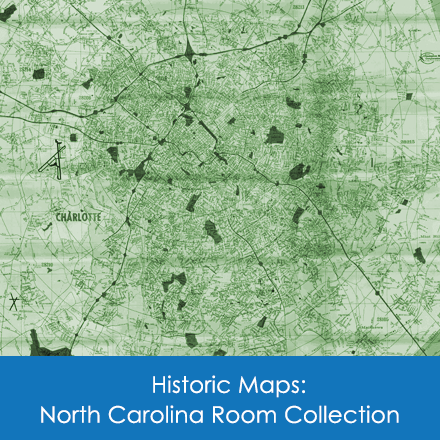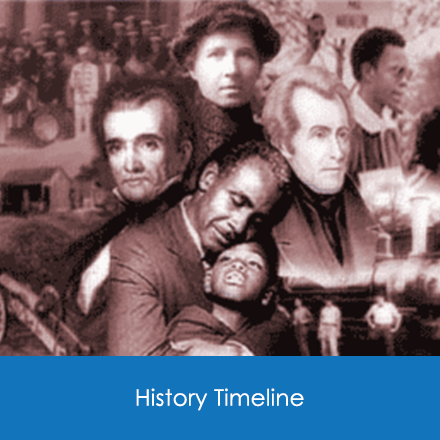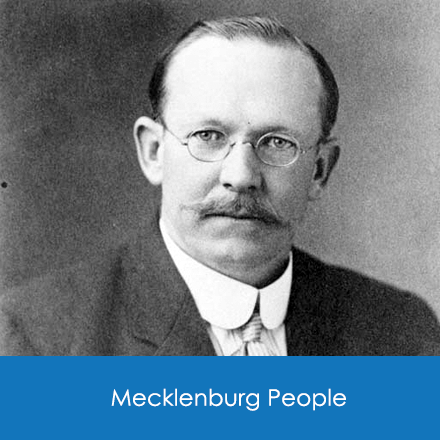You are here
Of Things Medical
THOUGH in no phase of Mecklenburg life would two centuries bring a greater advancement than in the field of medicine, Charlotte's present-day importance as one of the foremost medical centers in the South had its beginning in the early days of the region's settlement.
The first recorded visit of a resident physician in Mecklenburg was that of Dr. Joseph Kennedy in 1766, though earlier Dr. John Newman Oglethorpe of Rowan and a Dr. Cantzon, who is reported to have treated a man living in what is now Lincoln County, had practiced in this section. By far the most distinguished physician of the county's colonial years, however, was Dr. Ephraim Brevard, who earned his right to the acclaim of history as a leader in the fight for independence and as the principal author of the May 20, 1775, declaration. Dr. Brevard's practice was brief; he died on the eve of the achievement of independence.
A year before Dr. Brevard's death in July, 1781, Dr. Thomas Henderson, who had been a school teacher, began to practice medicine in little Charlottetown. He was the forerunner of other Hendersons who would establish themselves in Charlotte medicine in succeeding generations. He practiced for almost two score years.
Up in Hopewell about that time Dr. James R. Alexander, who would be the first of many Alexanders to become doctors in Mecklenburg, was establishing a large practice. In 1780, according to Tompkins' history of the county, "when the smallpox was epidemic in the county, having been brought here by the British and American armies," he vaccinated many of the people of his section. "In one family he vaccinated ten persons, charging one pound currency for each 'inoculation' - probably depreciated continental currency." The doctor must have used the scab method of inoculation in which scabs from a smallpox sufferer were employed to infect the patient with the dread disease. It was a dangerous method, though usually the case developing from such treatment was much less virulent than the regular cases. In 1796 Dr. Edward Jenner developed from animals infected with cowpox what is considered the progenitor of the modern method of vaccination against smallpox, and shortly after the beginning of the nineteenth century his method was brought to America.
Treatments commonly prescribed by the doctors of a century ago seem strangely primitive. Dr. J. B. Alexander in his county history in discussing medicine in Mecklenburg tells of the methods employed by two notable doctors of the early decades of that century, Dr. McKenzie and Dr. D. T. Caldwell, who formed a partnership about 1822. "One of the partners would go and see the patients on the south of town, and the other would go and see those on the north side. They would see all the patients every other day. This was the era of bleeding. Dr. Caldwell said that if he met a fresh case and failed to bleed from any cause, he felt sure McKenzie would bleed him tomorrow. If any case was doubtful, they would compromise by leeching. . . . It was a common sight to see two or more jars two-thirds full of water with a quantity of leeches floating about ready for use, in the drug store."
Doubtless similar treatments were given their patients by two other physicians of the early days, one of whom achieved distinction in politics rather than in medicine. He was Nathaniel Alexander, who became a member of the House of Commons and later the Senate in the General Assembly, a member of Congress, and Governor. The other was Dr. Joseph McKnitt Alexander, son of the May 1775 convention secretary and the county's most noted practitioner of the early eighteen-hundreds, whose practice extended to his death in 1841.
And these methods of treatment likely changed little in the first half of the nineteenth century.
Bleeding, which evidently was the method used in the treatment of many ailments, even anemia, doubtless hastened the health of some patients who might have survived had they escaped it. In 1845 a hog drover from Kentucky stopped overnight in Mecklenburg at the home of a man described as a "steam doctor." In the night the Kentuckian developed a violent chill that was followed shortly by a high fever. His host promptly bled him. When he quickly became violently ill, this steam doctor sent for a regular physician. This practitioner, another Alexander, Dr. M. W. Alexander, found the man suffering with erysipelas. Dr. Alexander declared the man should not have been bled, that the bleeding would hasten the patient's death. "Don't blame him, Doctor,' the hog drover said; "the damned fool had no better sense." The story indicates that at least there were some physicians even in those early days who knew that bleeding was not always advisable. The hog drover died and Dr. Alexander soon was a victim of the dread disease, and in the epidemic that followed, hundreds died in the northern section of the county.
What doctors in Mecklenburg prescribed, and what they charged for their medicines and services, in the period of the War Between the States is revealed in the records of a family of the Gilead community of northwestern Mecklenburg. The physician was the historian, Dr. Alexander himself, and the family was related to him. The statement, written on a pale blue sheet of account paper, is headed: "R. F. Blythe in account with J. B. Alexander for Medicines and Medical attention, 1868."
In the physician's careful handwriting the statement lists:
Jan. 2d.
To quinine 12 grs. .50
" 25th
Visit & prescription 1.25
Blue-fill & morphia .25
" 26th
Visit & Prescription 1.25
Morphia .25
" 27th
Visit & prescription 1.25
quinine .25
" 28th
Visit & prescription 1.25
quinine, morphia, & chloroform .50
" 30th
Visit & prescription 1.25
quinine .25
Feb. 2d
To quinine 10 grs. .50
" 26th
To blue-fill, & calomel .25
May 26th
To quinine .25
" "
To calomel .25
" 27th
Visit & prescription 1.00
" "
calomel, Powder & quinine .50
Aug. 5th
To quinine .25
Oct. 10th
Visit & prescription 1.25
cal. & quinine .25
" 11th
Visit & prescription 1.25
Swt. Spts. Nitre, & quinine .50
" 12th
Visit & prescription 1.25
quinine .25
" 13th
Visit & prescription 1.25
" 15th
Visit & prescription 1.25
cal. Morphia & Nitre .25
" 15th
Visit & prescription 1.25
__________
$20.00
In 1896 a great advancement in the science of medicine had its beginning in Mecklenburg County. It has been contended that the first X-ray picture made in America was made at Dartmouth College "on Saturday evening, either January 24 or February 1, 1896, probably the latter," according to an article in the Dartmouth Alumni Magazine of April, 1930. But such a picture was made on January 12, 1896, at Davidson College, the late Osmond L. Barringer, Charlotte automobile pioneer and historian, pointed out, and he was positive of both the date and the fact that the X-ray picture was made. In the first place, it was on a Sunday night, not the proper time for such activities in a strict Presbyterian community, and in the second place, he was one of the students who made the picture.
With young Barringer were Eben Hardie of New Orleans and Pender Porter, who later became a physician in Brooklyn. The boys had heard of the experiments of Wilhelm Conrad Roentgen at the University of Wurzburg in Bavaria. In November of the fall before, Roentgen while experimenting with some of his laboratory equipment had noticed mysterious X-radiations. Puzzled, he continued to experiment and on January 4 he announced that he had been able to make pictures through solids, and the X-ray was born.
The Davidson students had heard of the Roentgen experiments. So this Sunday night they decided to see if a contraption they had in the laboratory, called a Crookes tube, would take a picture like Roentgen's. It appeared by the information available that the equipment was quite similar.
They located the janitor and bribed him to let them have the keys. Then they went to the dissecting room - Davidson at that time had a medical school - and with a pocketknife sawed the finger from a cadaver. The finger still had a cheap ring on it. In the science laboratory they laid out on a photographic plate beneath the Crookes tube, the finger, with two straight pins stuck through it, a folding pocket magnifying glass, two cartridges, a pin, and two rings in a pill box, and a few other small articles. Then they turned on the current. Three hours later they turned off the electricity and young Barringer developed the picture. They had, those who have given much study to the subject of the X-ray are confident, the first X-ray photograph ever made in America! It was a clear picture; it has been reproduced many times in the two-thirds of a century since it was made.
The three boys at the time said nothing of their experiment, however. But, on February 27, 1896, the picture of an X-ray photograph made by Dr. H. L. Smith was published in the Charlotte Observer. The picture and the accompanying article were sensational. This picture was of the hand of a cadaver. "The hand," the newspaper article revealed, "was cut off a few inches above the wrist, Dr. Smith said, and he fixed a pistol ball into the fleshy part of the palm. He recalled that he then placed the hand over the photographic plate and exposed it to the ray for 15 minutes. When he developed the negative, he found that he had a perfect picture of all the bones in the hand and the bullet lodged between the third and fourth fingers in the palm."
Some weeks afterward Dr. Smith was instrumental in saving the life of a little girl who had swallowed a thimble. By using his crude X-ray equipment he was able to locate the thimble, which later was removed by three Charlotte surgeons in one of the first operations of the sort ever performed.
In 1903 Mecklenburg doctors organized the Mecklenburg County Medical Society, and it was hardly three years old when it was host to the physicians of North Carolina at the fifty-third regular annual session of the Medical Society of the State of North Carolina. The official record of the convention would describe the Charlotte meeting as "not only numerically the largest attended and with the largest number of papers ever presented, but with a professional esprit de corps manifest on every hand to an extent never before surpassed in the history of North Carolina medicine."
Dr. Edward C. Register of Charlotte was president of the state society that year; there were 41 other Mecklenburg physicians on the county society's first roster. Dr. Annie Lowrie Alexander, daughter of Dr. J. B. Alexander, one of the first women physicians in the South, presented a paper at the state meeting. A paper was also presented by Dr. James R. Alexander, who survived the meeting a half century, on the subject then being widely debated, "Physicians' Use of Automobiles." Dr. R. L. Gibbon was chairman of the committee on arrangements and called the session to order on May 29, 1906, in the Mecklenburg court house. Scores of papers on every phase of medicine were offered during the three-day convention. But the annual dinner - it did not begin until 10:30 that night - must have been the climactic event. The official journal of the convention summarizes the evening in a page and a half and describes it as "a most sumptuous banquet."
Covers were laid for 600 in the O'Donoghue Hall, the report discloses. The seats "were filled by the visiting doctors and their friends, the local doctors, and distinguished citizens of Charlotte." Fifteen toasts were offered. Charlotteans toasting and the subjects were: Dr. R. L. Gibbon, "Southern Medical Literature"; Dr. John R. Irwin, "The Age of Medical Research"; Dr. J. P. Munroe, who then lived at Davidson, "Southern Medical Schools"; D. B. Smith, Charlotte lawyer, "Medical Jurisprudence"; and W. C. Maxwell, "Our Ancestors and Ourselves." Charlotte's Dr. R. J. Brevard was toastmaster.
Revealing, if also highly amusing, was the discussion in those early days of the twentieth century of the use of the automobile by the physician. At the same time the state society was meeting in Charlotte in 1906 a 35-page article in the Journal of the American Medical Association was being widely read and discussed; in this article 66 American doctors listed the advantages and disadvantages of using the automobile in medical practice. One Carolina physician declared "there is no question about the usefulness of an automobile to a physician. It is so much quicker and can be left standing anywhere without an attendant. It can easily cover twice the ground in a day that a horse can. . . ." Another declared that "for the overworked doctor the auto is better than medicine, vacation, or religion," and added that "it makes one forget he is living or that one day he must die." Still another describing the proper car for a doctor's use, said, among many things, that "it must not have pneumatic tires. . . . It must be air cooled. . . . It should have at least two cylinders. . . ." One physician reported that the cost to him for a car and one year's operation was $840.80. . . . Time saved in making trips, said he, was 40 per cent. Speed, he said, was immaterial. "Fifteen miles an hour is fast enough. There should be a law forbidding a manufacturer from building an auto that would go faster than 20 miles an hour."
In November, 1953, in a two-day program rivaling the convention in Charlotte in May, 1906, the Society commemorated the fiftieth anniversary of its founding. The scientific program was developed around papers and motion pictures discussing the use of the heart-lung machine in the surgical treatment of heart ailments.
On its fiftieth anniversary the Society's original list of forty-two physicians, of whom five were still living and a sixth, Dr. Parks M. King, its first secretary-treasurer, had just died, had increased to upward of 200, and in 1960 the membership had grown by some fifty per cent to more than 300.
The Mecklenburg Bar Association, which lists a membership almost as large as the medical group, through the years has included lawyers and members of the state and federal judiciary who likewise have achieved wide distinction. From the first lawyer of more than community esteem, Charlottetown's Waightstill Avery, to the late Judge John J. Parker, senior judge of the United States Fourth Circuit Court of Appeals, Mecklenburg has had many lawyers of unusual ability.
Perhaps no lawyer or jurist who ever lived in Mecklenburg attained the international distinction earned by Judge Parker, who came to Charlotte from his native Union County shortly after receiving his license to practice. As a comparatively young man he was recognized for his learning in the law and was nominated by President Hoover for a seat on the United States Supreme court. But unfortunately and unfairly, he was refused confirmation by the United States Senate. By one vote, though his own Republican party could easily have confirmed the President's nomination, he lost. But without bitterness and with renewed application of his keenly analytical legal mind to the problems brought before him, he continued to serve with great distinction on the Circuit Court of Appeals. Long before his death Judge Parker was recognized throughout the nation as the ablest jurist in the federal system, including the members of the Supreme Court bench itself. His most widely publicized assignment, no doubt, was that of serving as one of the two American judges at the Nuremberg war trials.
Blythe, LeGette and Brockmann, Charles Raven. Hornets' Nest: The Story of Charlotte and Mecklenburg County. Charlotte, NC: Public Library of Charlotte and Mecklenburg County, 1961.


